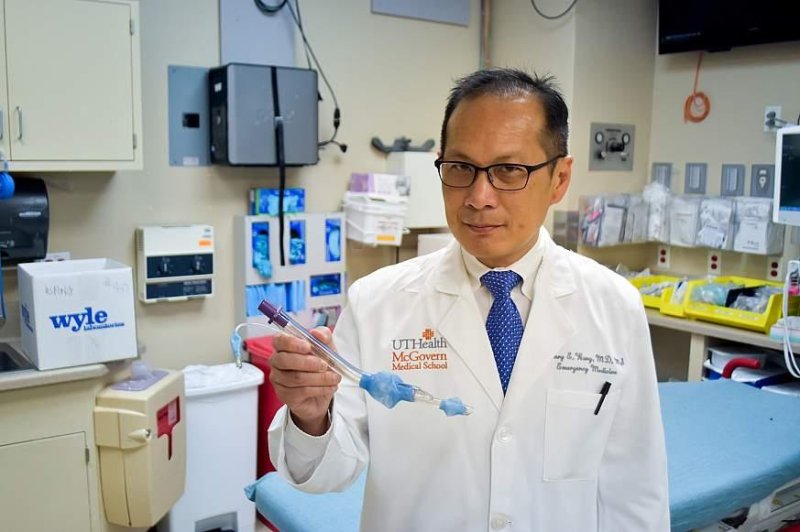Dr. Henry Wang, a researcher at the University of Texas Health Science Center at Houston, displays a newer type of emergency breathing tube that researchers say could save thousands of lives. Photo by
Rob Cahill/UT Health
Aug. 29 (UPI) -- If paramedics change the type of breathing tube they use, patients in cardiac arrest may have a better chance of survival -- preventing as many as 10,000 deaths per year -- according to a new study.
The research, which was published Tuesday in the Journal of the American Medical Association, may be the first to demonstrate that a particular airway intervention can positively affect patient survival rates.
The research was funded by the National Heart, Lung and Blood Institute, which is part of the National Institutes of Health, and led by the University of Texas Health Science Center at Houston.
A heart attack usually causes sudden cardiac arrest. When the heart suddenly or unexpectedly stops beating, blood flow is cut off to the brain and other vital organs.
Ninety percent of Americans with sudden cardiac arrest die before reaching a hospital or soon afterward, according to the American Heart Association. EMS providers treat the majority of the 400,000 out-of-hospital cardiac arrests each year.
"During resuscitation, opening the airway and having proper access to it is a key factor for the survival of someone who goes into cardiac arrest outside of a hospital," study coauthor Dr. George Sopko, program director in the NHLBI's Division of Cardiovascular Sciences, said in a press release. "But one of the burning questions in prehospital emergency care has been, 'Which is the best airway device?' "
The technique mainly used for resuscitation in the past three decades has been endotracheal intubation -- the insertion of a plastic tube into the trachea to maintain an open airway.
"While identical to techniques used by doctors in the hospital, intubation in these severe and stressful prehospital settings is very difficult and fraught with errors," said Dr. Henry E. Wang, lead author of the study and vice chairman for research in the Department of Emergency Medicine at McGovern Medical School at The University of Texas Health Science Center at Houston.
New devices are easier to use in opening and accessing an airway, including laryngeal tubes. This leads to better blood flow and oxygen delivery, the researchers said.
For the Pragmatic Airway Resuscitation Trial, researchers compared survival rates among 3,004 adults with cardiac arrest treated by paramedic crews from 27 EMS agencies in Birmingham, Ala.; Dallas-Fort Worth; Milwaukee; Pittsburgh; and Portland, Ore. About half of them received the newer laryngeal tube treatment, and the other half received traditional endotracheal intubation. The study period was from December 2015 to November 2017.
Among those receiving the new technique, 18.3 percent survived three days in the hospital and 10.8 percent survived to reach hospital discharge. For traditional endotracheal intubation, the survival numbers were 15.4 percent after three days of hospitalization and 8.1 percent for discharge.
In addition, the percentage of patients surviving with good brain function was higher in the laryngeal tube group.
"This study demonstrated that just by managing the airway well in the early stage of resuscitation, we could save more than 10,000 lives every year," Sopko said.















